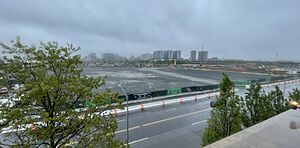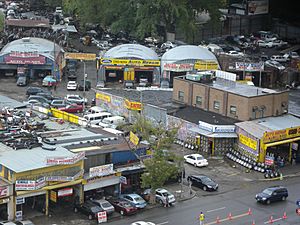Willets Point, Queens facts for kids
Quick facts for kids
Willets Point
|
|
|---|---|
|
Neighborhood of Queens
|
|

Willets Point in 2024
|
|
| Country | |
| State | |
| City | |
| County/Borough | |
| Community District | Queens 7 |
| Population | |
| • Estimate
(2011)
|
10 |
| Time zone | UTC−5 (Eastern) |
| • Summer (DST) | UTC−4 (EDT) |
| ZIP Code |
11368
|
| Area codes | 718, 347, 929, and 917 |
Willets Point, also called the Iron Triangle, is an industrial neighborhood. It is located in Corona, a part of the New York City borough of Queens. This area is east of Citi Field and close to the Flushing River.
Willets Point has been known for its many car repair shops and junkyards. In 2011, only about 10 people lived there.
Ideas to rebuild Willets Point started after World War II. These plans became more serious in 2007. City leaders and the few people living there did not like the first plan. This led to several years of legal battles.
In 2011, the city began a huge $4 billion project. The goal was to build new shops, homes, an entertainment area, and a public school. The New York City Economic Development Corporation's plan was approved in 2013. Old industrial buildings in Willets Point began to be torn down in 2016.
The new development was supposed to open in stages from 2018 to 2032. However, a New York state court stopped the building of a large shopping center. The plans were then changed and approved again in February 2018.
Contents
What is Willets Point Like?
Willets Point is bordered by Northern Boulevard to the north. To the west are 126th Street and Citi Field. Roosevelt Avenue and Flushing Meadows–Corona Park are to the south. The Flushing River is to the east.
The New York City Subway's Mets–Willets Point station is in the southwest part of the area. It serves the 7 <7> trains train. This station is at Roosevelt Avenue and 126th Street. The neighborhood is part of Queens Community District 7.
Most of Willets Point is set aside for industrial work. As of 2013, it had no sidewalks or sewers. Because of the area's low-lying land and unpaved roads, it often floods when it rains heavily. The area mainly has car repair shops, scrap yards, and waste processing businesses. It has been called "post-apocalyptic" because of its appearance.
A study in 2006 found that Willets Point was a special place for car parts and repairs. At that time, about 225 businesses operated there. They employed between 1,400 and 1,800 people. The large number of car repair shops gave the area its nickname, the "Iron Triangle."
History of Willets Point
The area gets its name from Willets Point Boulevard. This road used to cross a bridge over Flushing Creek. The original Willets Point is a cape where Fort Totten is located. This fort is near Bayside.
Over time, the name "Willets Point" started to be used for the area along the Flushing River. The name comes from the Willets family. The government bought their land in 1857 to build Fort Totten.
By the end of World War II, Willets Point was known for its car junkyards. Many plans to rebuild the area were suggested over the years, but none happened. Before the 1964 New York World's Fair, city planner Robert Moses tried to include Willets Point in Flushing Meadows–Corona Park. However, the junkyard owners hired a lawyer, Mario Cuomo, and stopped him.
Shea Stadium opened in 1964. It was home to the New York Mets baseball team and the New York Jets football team.
Stadiums and Sports in Willets Point
After the Jets football team left Shea Stadium in 1983, there were talks about building a new football stadium in Willets Point. This stadium would have brought the Jets back to New York. Other teams, like the St. Louis Cardinals and Atlanta Falcons, were also considered for the site.
By the 1990s, the Mets baseball team wanted a new stadium because Shea Stadium was getting old. New York City Mayor Michael Bloomberg started planning to redevelop Willets Point in 2002.
Citi Field was first planned as part of New York City's bid for the 2012 Summer Olympics. The city lost the bid, but plans for Citi Field continued. Shea Stadium was torn down in 2009 after Citi Field was finished.
Since 2009, Willets Point has been considered for other sports teams. The New York Islanders hockey team thought about moving there before they built UBS Arena. Currently, Willets Point is planned to be the home of a new stadium for New York City FC, a soccer team.
Redevelopment Plans and Changes
The Original City Plan
In 2011, the $4 billion redevelopment project officially began. The next year, the city changed the plan. It now included a mall with 200 stores and 2,500 new homes. About 875 of these homes would be affordable housing. This change made some people who first supported the project now oppose the mall.
A detailed report on the environmental impact was released in 2013. The redevelopment area included four parking lots around Citi Field. It also included a special "Willets Point District" where most of the industrial businesses were. In October 2013, the City Council approved the Willets Point redevelopment plan.
The first part of the plan, Phase 1A, was expected to finish in 2018. It included a 200-room hotel and a retail area. A temporary parking lot would also be built. This lot would host events for at least half the year.
A large mall was also planned. It would have 1,000,000 square feet of retail space and up to 200 stores. The mall would also have a food court, a movie theater, and a new parking garage. Even after Phase 1A, some parts of Willets Point would still be used for car and industrial businesses.
Phase 1B of the plan would take ten more years, finishing by 2028. The temporary parking lot would slowly be turned into homes, shops, another hotel, offices, and a public school. It would also include 6 acres of parkland. The city set aside $66 million to design and build new ramps for the Van Wyck Expressway to serve this area.
New Housing was planned for the second phase, to be done by 2032. There would be 2,490 housing units. About 35% of these, or 1,000, would be affordable homes. The plan also allowed for more retail space, office space, a new convention center, and more hotel rooms. A community center, a public school, and 8 acres of parkland were also part of this phase.
How the Plan Changed
In 2014, Bill de Blasio became the new mayor of New York City. He did not like the redevelopment plan because it did not have enough affordable housing. However, the City Council approved the project in 2015.
A state senator, Tony Avella, and a small community group sued to stop the mall. In June 2015, a state court ruled that the mall could not be built on a parking lot in Willets Point. The developers tried to appeal, but the city government did not join them.
By mid-2016, the last car repair shops in the area had closed. Demolition of buildings began for the $4 billion project. Most business owners either closed down or moved to Hunts Point, Bronx. Actual construction on the shopping area was stopped by the 2015 lawsuit. The lawsuit argued that the retail area was planned for a part of the neighborhood that was legally part of Flushing Meadows–Corona Park. In June 2017, the New York Supreme Court ruled against building the mall.
In February 2018, the de Blasio administration and developers reached a new agreement. This plan included 1,100 apartments for lower- and middle-income families. It also had a school for 450 students, parks, and 6 acres of retail space. The new plan did not include a large mall.
Under this agreement, the developers, The Related Companies and Sterling Equities, were supposed to clean up all toxic materials by 2020. The first 500 apartments were expected to open by 2022. The project was delayed again until May 2021. At that time, the Queens Borough Board voted to let the first phase of the development move forward. A groundbreaking ceremony happened on June 16, 2021. This marked the start of a three-year project to clean up pollution at the site.
In November 2022, the government of New York City and New York City FC agreed to build a 25,000-seat soccer stadium in Willets Point. The stadium is expected to be ready in 2027. It will be part of a larger development with a 250-room hotel and 2,500 homes on a 23-acre lot.
Willets Point in Pop Culture
Willets Point has inspired artists and filmmakers. The "Valley of Ashes" in F. Scott Fitzgerald's famous novel The Great Gatsby is said to be based on a former dump in Willets Point. This dump is now where Flushing Meadows–Corona Park is located.
The 2007 movie Chop Shop was filmed and set in this neighborhood. The 2010 dramatic film Willets Point, directed by T. J. Collins, also takes place in the neighborhood.
The 2018 documentary The Iron Triangle tells the story of how this once busy neighborhood was changed. The 2010 documentary “Foreign Parts” was also filmed in Willets Point. It shows what life and work were like there before the redevelopment started.




